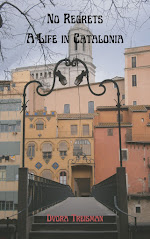There was recently an article in the local paper about several small
Romanesque churches that are hidden away and neglected in small
villages all around this area. People are now starting to recognize
them for the treasures that they are, especially since tourists like
to go and see them. I had never seen or heard of most of them so I
decided I would seek them out.
Friday seemed as
good a time as any to find the first one, and I called Josep – he
of the ants -- who still doesn’t have his car back from the shop,
to see if he wanted to come. He did. But he thought we should go to
the sanctuary Mare de Déu
del Mont. This was not
on the list. However,
he’s been going on
about this Mare de Déu
for a couple of years. He says it’s very close by. You take the
highway towards
Olot, turn off, and then go a ways – not too far – up a road that
has some curves. He
knows I don’t do well on curves. Those
curves and Covid are the reasons why I never went there with him.
And anyway,
on Friday my
idea was to see one of those Romanesque churches. But
Mare de
Déu
del Mont
has a VIEW, he said.
Never mind that it
was not a particularly clear day.
We
went to Mare de Déu
del Mont. That little
road wasn’t simply curvy. It was the windiest road I’ve ever
been on. It started
out being wide enough for two cars, but it narrowed down to about a
lane and a half. Keep
in mind that small roads here usually have no shoulder. And
on that lane and a half were countless
curves and 11
of the tightest hairpin
turns I’ve ever seen (I
counted them later on a map).
I never got out of
second gear. If a car
was coming the other way on
a hairpin, you wouldn’t
see it until it was smack in front of you and the one coming downhill
would have to back up for the one going uphill to pass by. It went
on and on for about 18
very long kilometers.
Thank God, (or the Mare de
Déu)
that I was the one doing the driving; if not I would have been a very
sick girl. If Josep was
gritting his teeth, it served him right.
Thankfully,
I never did encounter a car coming in the opposite direction on any
of those hairpins, in fact there were almost no cars – just several
bicyclists and one lone man walking. Hats off to all of them.
Josep had also mumbled something about
Romanesque, and there it was. About half way up was the 10th
century Benedictine abbey of Sant Llorenç
de Sous. Founded in 922, it was celebrating its 1100th
anniversary. Damaged by earthquakes in the 15th century,
it was finally abandoned in the 18th.
It
was after the abbey that we encountered all those hairpin curves.
Once at the top, yes, the view was gorgeous. There was the plain
below dotted with crops and villages; the hills of La Garotxa, many of them inactive volcanos; I picked out the village of
Besalú; and of course, the
magnificent snow-covered mountain Canigó,
which I see often, from
further away, on my walks at Vilabertran and also from the beach at
Empuriabrava.  |
| Besalú and the hills of Garrotxa |
.JPG) |
The lone walker on the right, talking with another visitor
|
Canigó, at
the eastern end of the Pyrenees,
is situated in France, but
that part of France was once part of Catalonia. At 2784 meters, it
is the highest peak in the area and can be seen from all over
northern Catalonia and southern France. It has a special meaning to
Catalans and the Catalan flag flies at its top. There is a tradition
on the 23rd
of June, the eve of Sant Joan (Saint John, the summer solstice) to
build a big bonfire at the top of the mountain. People come from all
over Catalonia to light torches from that bonfire and take
them to their towns and villages to
have nighttime marches and
light local bonfires.
Shifting
over and looking towards Besalú,
first one flew by, then two, then several, then a dozen. Vultures.
Griffon vultures.
When
he got to the top, I congratulated that lone walker on his climb, He
replied that it was just a stroll. I asked him if he knew anything about
the birds and he explained to me that they had disappeared from the
area years ago, following the livestock farms into less populated
areas in the Pyrenees, but recently the Catalan government was
reintroducing them by putting out food on the nearby cliffs. I had
thought they were falcons, but he said no. Falcons flap their wings;
the vultures just glide with the air currents.
A
Romanesque church, a spectacular view of snow-covered Canigó,
a kettle of vultures, and
the adventure of driving on the windiest road in the world in my
little 20-year-old Citroen. It was a good day.
.JPG)
.JPG)
.JPG)

















.JPG)




.JPG)




.JPG)
.JPG)
.JPG)
.JPG)

.JPG)

